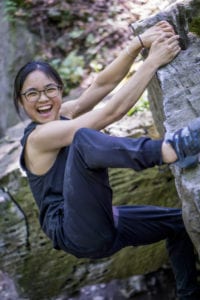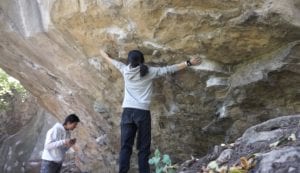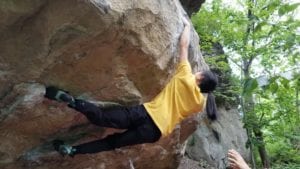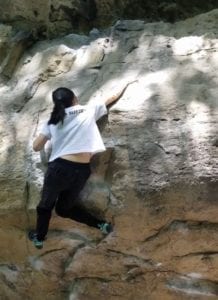Maria Cheng Climbs Ontario’s Most Notorious Boulder
Ontario boulderer Maria Cheng has climbed The Gunt, a problem that was once impossible for shorter climbers.

Some problems have a character to them. Perhaps they remain unrepeated for years or become a staple of the area. In whichever case these problems are special to their communities.

Although the Niagara Glen has achieved a degree of notoriety in these last 18 months, the area remains a hole-in-the-wall within the context of North American climbing. Still, there exist problems that have become special. The Gunt is one such boulder.
Sitting a stone’s throw from the bottom of the staircase, The Gunt rests enthroned in a wave of Dolomite. Although much of the Glen’s bouldering exists as a result of a series of blasts from the adjacent cliffside, The Gunt persists on a wave-like overhang carved from some of the area’s best Limestone.
Historically, the problem earned itself a small place in Canadian rock climbing. First ascensionist Tim Doyle established the boulder during a trip to Ontario. Doyle’s name has become synonymous with Canadian development. He likely holds the title: most prolific Canadian bouldering developer. He is most famous for his work in Squamish.
For Glen locals, the problem has persisted as one of the more challenging boulders of the grade. The V10 originally called itself V11, but lost a point following a break that may or may not have made the boulder significantly easier. Today, there remain strong climbers that take V11 for the problem.

In recent years, the boulder has come under scrutiny for its name. The misogynistic title of the problem came long before its first ascent. It was once the Gunt project, and the project name stuck. Although the problem will likely be renamed, a new name has not yet been found.
Despite its origins, many women have spent a portion of their bouldering careers striving to climb this famous problem. The great difficulty for many of these athletes comes from the second move. Climbed in sequence, conventional beta asks the climber to post up on their left foot before making a large span that, hold-to-hold, measures somewhere between 5’2” and 5’4”.
The strongest women in the Glen have conventionally stood between 4’11” and 5’3” with ape indexes that reach with difficulty to, or through, that span. For most of the climbers that have ascended this problem, that second move does not approach the crux in difficulty. For shorter athletes, it often becomes the crux, equal to the crux, or remains impossible. Locals have long awaited a shorter beta for this problem. Maria Cheng would develop this beta.
The 24-year-old boulderer has been on a tear in these last months. Most notable for her ferocious finger strength, the athlete has ascended many of the Glen’s locally famous test pieces.
She would climb the first female ascent (FFA) of Seppuku, a radical V10 that many believe to be the best V10 in the area. She would also climb BFF, a boulder that only received its FFA last year from Ontario climber Pia Graham.
Cheng would ascend numerous V9’s as well, but there still remained The Gunt. Breaking down multiple betas with Ontario boulderer Midori Buechli, Cheng would learn her way through the cruxy bottom section of the climb. Ultimately, at 5’ 0”, Cheng would learn to circumvent the span with a unique beta all her own.
“It was so frustrating at The Gunt when I first tried it. All of my friends could reach the move. That was not the hard part. I remember I couldn’t even start on the giant span move because my face was up against the wall. I really did feel quite defeated… It took me a really long time to figure out this pinch on the left-hand rail. It’s really good and I could actually use it to get the next hold.”
Although Cheng would profess this pinch to be “really good,” standing through the pinch to match, as it is an under-cling, provides one of the more challenging sequences on the climb. From that hold, she would then move to the finger-bucket that most people span to.

Originally motivated by the next-level nature of the climb, Cheng would pour herself into refining the beta and finding her way to the top.
“There are two jugs you would normally start on. I am not sure if it is allowed, but I started with both hands on the left jug. There is a left rail for your foot, and I kind of prop my right foot up on one of the starts. I extend my left hand up into the undercling, but you want to get as high as possible in more of a meat-hook position. It’s hard when you are short because it is above your head. Then you really push on the foot and pull on the hand. Swap feet, get your left foot up onto this small foot crimp. Get your right foot out on another edge that’s close to the start hold. You kind of drop your right knee in and match the pinch. That’s also one of the cruxes. You can tell when you can or can’t match based on how good your left hand is.
“From there you squeeze the pinch really hard, and you are basically at the jug. Then you kind of do the same moves [as taller people] getting the pinch out on the face. For the bicycle, I think this is Midori’s beta, I used the top face of the edge to balance with a toe against it. It let me bump higher to the sloper-crimp because my body is not so low. From there, you cut your feet, get a right foot, and slap for the side-pull. My foot would always cut. I think that move is really hard. I then realized getting my left foot up as well let me pull high enough so that I could stick the move. You have to be very confident there too. From there you get your right foot up, mantle, hand-foot match and finish.”

Cheng concluded the boulder with notably alternate start beta. This flexes the unique manner in which climbing exists and potentially offers an opportunity for further conversation. She reflected on her motivations and found her reason for picking this project.
“I think what motivated me for Seppuku and The Gunt was being crushed initially by the impossibility of the climb. This posed unique challenges to my own body type which heightened my pride in the beta I came up with and pushed me to send the climb. I understand how the mental block feels, and I want to share the possibility of alternate solutions with other people.”
Naturally, Cheng has set her sights on further debilitatingly morpho lines, such as the Phoenix V11. Potentially even more spanny than The Gunt, Cheng looks toward another year of hard projecting as one of Ontario’s strongest outdoor boulderers.


